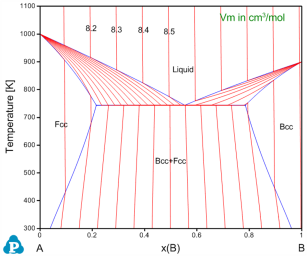Add User-defined Properties to the Original Database
As is well known, the CALPHAD method has now been used to describe various types of phase properties in addition to thermodynamic properties. Mobility databases, molar volume databases and other thermo-physical property databases can be developed via similar route as that of developing a thermodynamic database. The Append TDB function allows a user to add user-defined properties to an original database. In this example, we add molar volume to AB_Original.tdb via the Append TDB function. The molar volume parameters of A and B within the Bcc, Fcc, and Liquid phases are described in the AB_property.tdb database as listed below:
Parameter Vm(Bcc,A;0) 298 +7.4e-6*exp(1e-6*T); 3000 N !
Parameter Vm(Bcc,B;0) 298 +8.4e-6*exp(1e-6*T); 3000 N !
Parameter Vm(Fcc,A;0) 298 +7.0e-6*exp(1e-6*T); 3000 N !
Parameter Vm(Fcc,B;0) 298 +8.0e-6*exp(1e-6*T); 3000 N !
Parameter Vm(Liquid,A;0) 298 +8.0e-6*exp(1e-6*T); 3000 N !
Parameter Vm(Liquid,B;0) 298 +9.0e-6*exp(1e-6*T); 3000 N !
Load the original database AB_original.tdb and then append the AB_property.tdb database via the Append TDB function. The currently combined AB_original + AB_property database enables us to calculate molar volume of the A-B binary system in addition to the phase diagram. The molar volume contour lines are shown in Figure 1 (refer to Section Contour Diagram for calculating contour diagrams). Moreover, density and linear thermal expansion coefficient can also be calculated with this AB_original + AB_property database.
Please note that, various types of user-defined properties including but not limited to atomic mobility, molar volume, viscosity, surface tension can all be combined with the original thermodynamic database via the Append TDB function.
